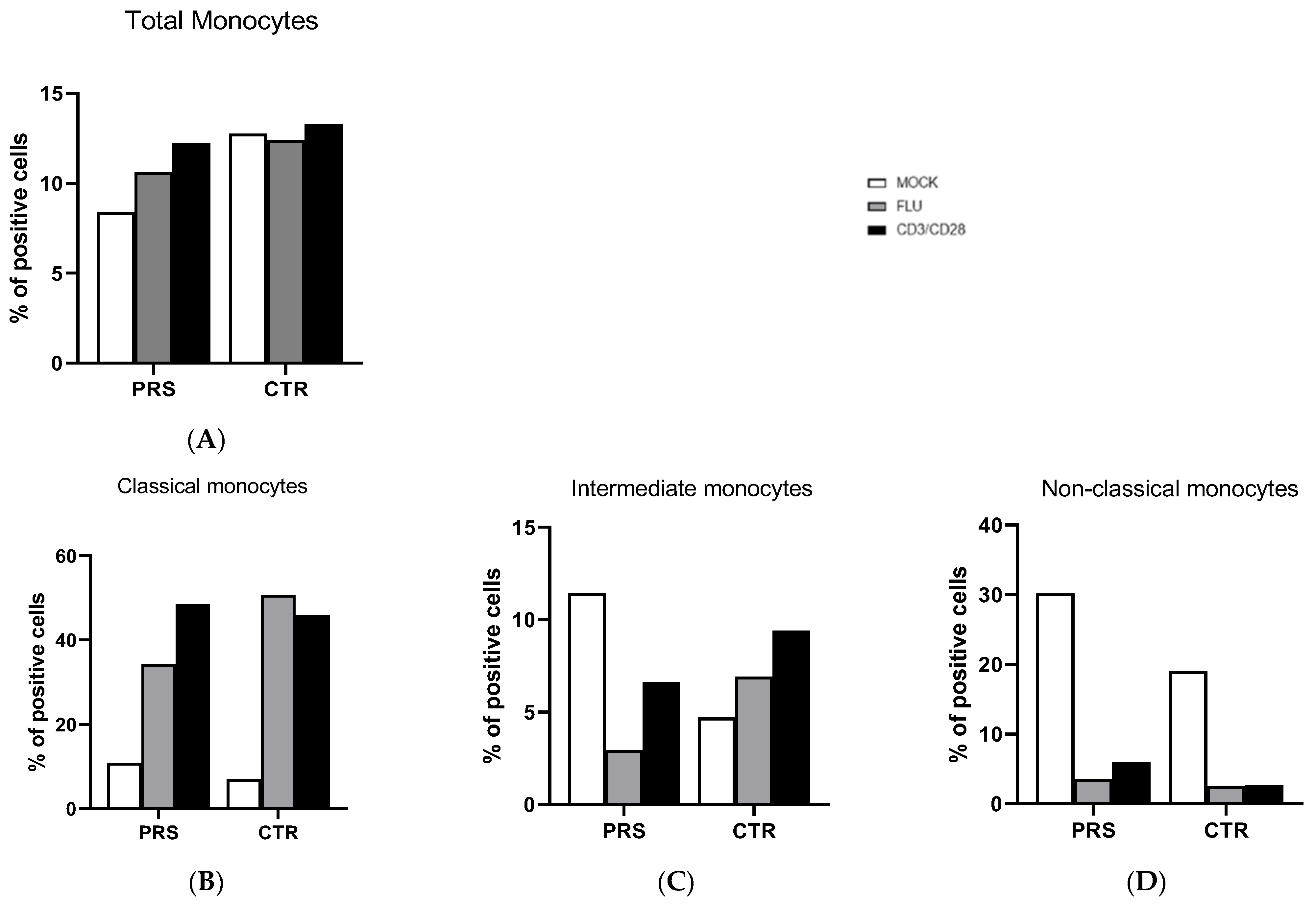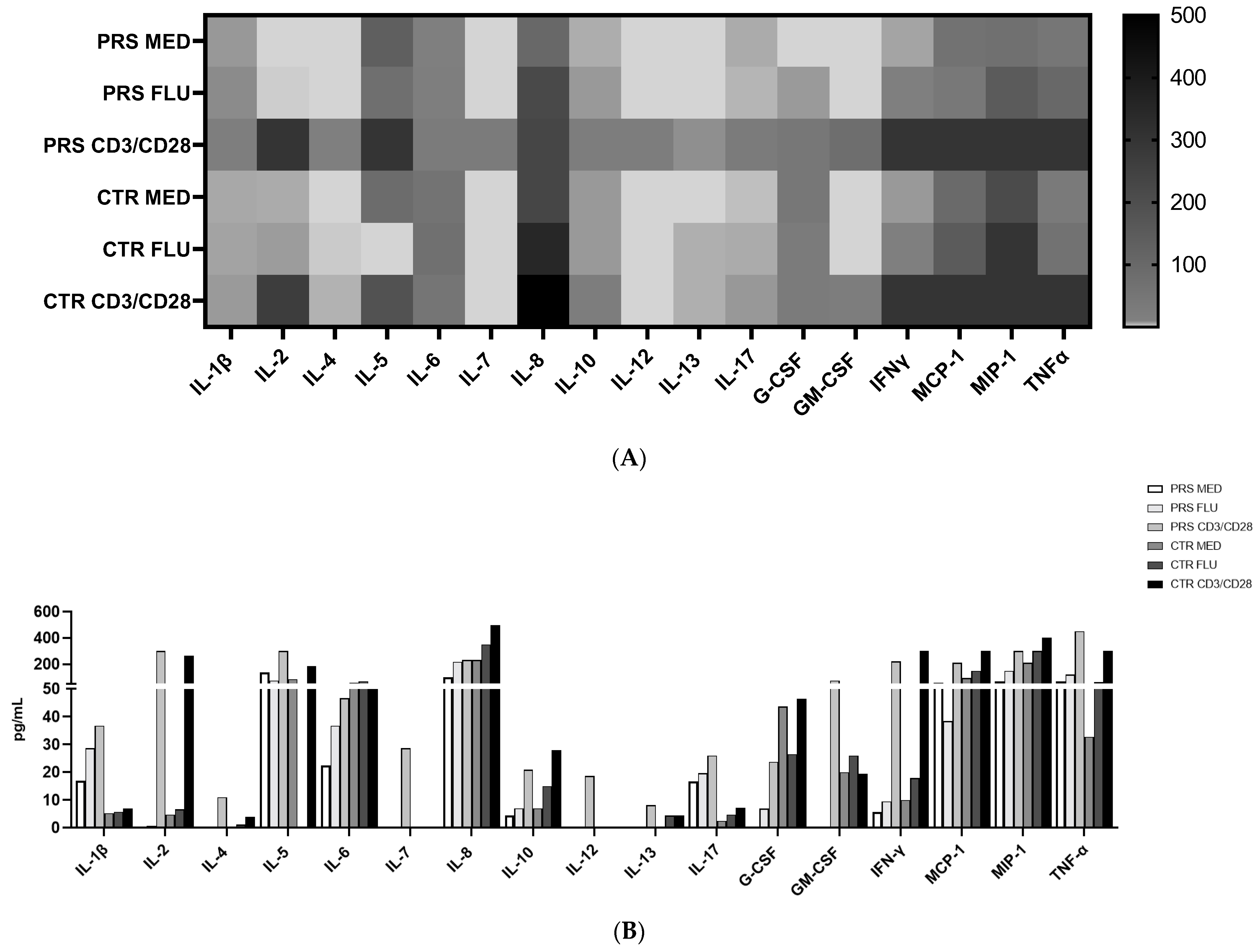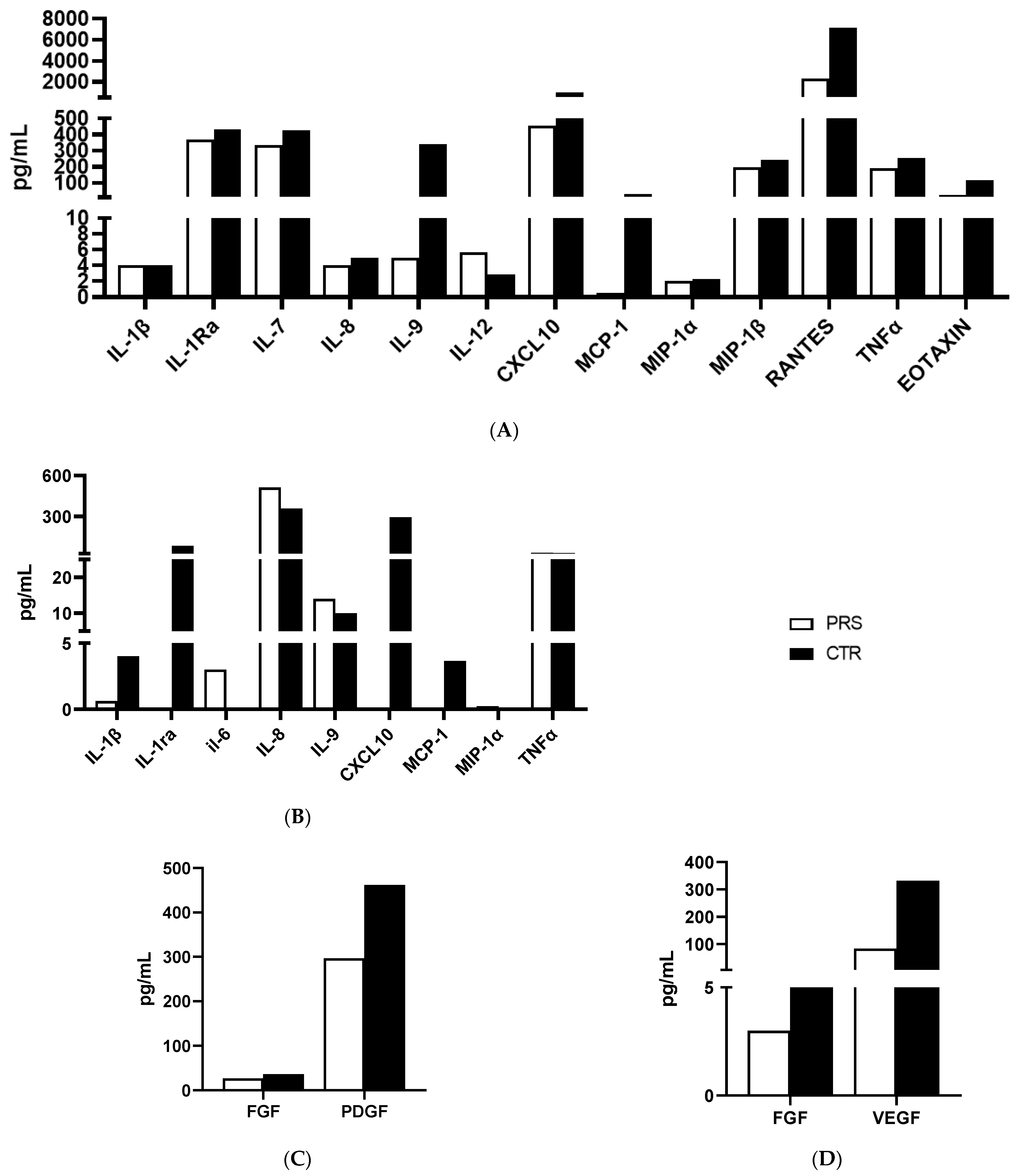Immunological Profiles in Parry–Romberg Syndrome: A Case–Control Study
Abstract
:1. Introduction
2. Materials and Methods
2.1. Patients’ Description
2.2. Saliva Plasma and PBMC Isolation
2.3. Cell Culture Conditions
2.4. Flow Cytometry Analysis
2.5. Multiplex Cytokine Analyses
3. Results
3.1. B Cell Subpopulations
3.2. T Cell Subpopulations
3.3. Monocyte Subpopulations
3.4. Cytokine/Chemokine Concentration in Cell Culture Supernatant, Plasma, and Saliva
4. Discussion
5. Study Limitations
Supplementary Materials
Author Contributions
Funding
Institutional Review Board Statement
Informed Consent Statement
Data Availability Statement
Conflicts of Interest
References
- Bucher, F.; Fricke, J.; Neugebauer, A.; Cursiefen, C.; Heindl, L.M. Ophthalmological Manifestations of Parry-Romberg Syndrome. Surv. Ophthalmol. 2016, 61, 693–701. [Google Scholar] [CrossRef]
- Tolkachjov, S.N.; Patel, N.G.; Tollefson, M.M. Progressive Hemifacial Atrophy: A Review. Orphanet J. Rare Dis. 2015, 10, 39. [Google Scholar] [CrossRef]
- Schultz, K.P.; Dong, E.; Truong, T.A.; Maricevich, R.S. Parry Romberg Syndrome. Clin. Plast. Surg. 2019, 46, 231–237. [Google Scholar] [CrossRef]
- Arif, T.; Fatima, R.; Sami, M. Parry-Romberg Syndrome: A Mini Review. Acta Dermatovenerol. Alp. Pannonica Adriat. 2020, 29, 193–199. [Google Scholar] [CrossRef] [PubMed]
- Pensler, J.M.; Murphy, G.F.; Mulliken, J.B. Clinical and Ultrastructural Studies of Romberg’s Hemifacial Atrophy. Plast. Reconstr. Surg. 1990, 85, 669–674; discussion 675–676. [Google Scholar] [CrossRef] [PubMed]
- Wong, M.; Phillips, C.D.; Hagiwara, M.; Shatzkes, D.R. Parry Romberg Syndrome: 7 Cases and Literature Review. AJNR Am. J. Neuroradiol. 2015, 36, 1355–1361. [Google Scholar] [CrossRef]
- Maletic, J.; Tsirka, V.; Ioannides, P.; Karacostas, D.; Taskos, N. Parry-Romberg Syndrome Associated with Localized Scleroderma. Case Rep. Neurol. 2010, 2, 57–62. [Google Scholar] [CrossRef] [PubMed]
- Asano, Y.; Fujimoto, M.; Ishikawa, O.; Sato, S.; Jinnin, M.; Takehara, K.; Hasegawa, M.; Yamamoto, T.; Ihn, H. Diagnostic Criteria, Severity Classification and Guidelines of Localized Scleroderma. J. Dermatol. 2018, 45, 755–780. [Google Scholar] [CrossRef] [PubMed]
- Glaser, D.H.; Schutt, C.; VonVille, H.M.; Schollaert-Fitch, K.; Torok, K. Linear Scleroderma of the Head-Updates in Management of Parry Romberg Syndrome and En Coup de Sabre: A Rapid Scoping Review across Subspecialties. Eur. J. Rheumatol. 2020, 7, S48–S57. [Google Scholar] [CrossRef] [PubMed]
- Saulle, I.; Ibba, S.V.; Torretta, E.; Vittori, C.; Fenizia, C.; Piancone, F.; Minisci, D.; Lori, E.M.; Trabattoni, D.; Gelfi, C.; et al. Endoplasmic Reticulum Associated Aminopeptidase 2 (ERAP2) Is Released in the Secretome of Activated MDMs and Reduces in Vitro HIV-1 Infection. Front. Immunol. 2019, 10, 1648. [Google Scholar] [CrossRef]
- Thoreau, B.; Chaigne, B.; Mouthon, L. Role of B-Cell in the Pathogenesis of Systemic Sclerosis. Front. Immunol. 2022, 13, 933468. [Google Scholar] [CrossRef] [PubMed]
- Yoshizaki, A. Pathogenic Roles of B Lymphocytes in Systemic Sclerosis. Immunol. Lett. 2018, 195, 76–82. [Google Scholar] [CrossRef] [PubMed]
- Beesley, C.F.; Goldman, N.R.; Taher, T.E.; Denton, C.P.; Abraham, D.J.; Mageed, R.A.; Ong, V.H. Dysregulated B Cell Function and Disease Pathogenesis in Systemic Sclerosis. Front. Immunol. 2022, 13, 999008. [Google Scholar] [CrossRef] [PubMed]
- Castleman, M.J.; Santos, A.L.; Lesteberg, K.E.; Maloney, J.P.; Janssen, W.J.; Mould, K.J.; Beckham, J.D.; Pelanda, R.; Torres, R.M. Activation and Pro-Inflammatory Cytokine Production by Unswitched Memory B Cells during SARS-CoV-2 Infection. Front. Immunol. 2023, 14, 1213344. [Google Scholar] [CrossRef] [PubMed]
- Zhang, W.; Wang, Y.-F.; Hu, F.-L.; Lu, F.-A.; Wu, T.; Feng, Y.-L.; Li, K. Dysfunction of CD27+IgD+ B Cells Correlates with Aggravated Systemic Lupus Erythematosus. Clin. Rheumatol. 2022, 41, 1551–1559. [Google Scholar] [CrossRef] [PubMed]
- Rodríguez-Bayona, B.; Ramos-Amaya, A.; Pérez-Venegas, J.J.; Rodríguez, C.; Brieva, J.A. Decreased Frequency and Activated Phenotype of Blood CD27 IgD IgM B Lymphocytes Is a Permanent Abnormality in Systemic Lupus Erythematosus Patients. Arthritis Res. Ther. 2010, 12, R108. [Google Scholar] [CrossRef] [PubMed]
- Feng, R.; Zhao, J.; Sun, F.; Miao, M.; Sun, X.; He, J.; Li, Z. Comparison of the Deep Immune Profiling of B Cell Subsets between Healthy Adults and Sjögren’s Syndrome. Ann. Med. 2022, 54, 472–483. [Google Scholar] [CrossRef] [PubMed]
- Chizzolini, C.; Dufour, A.M.; Brembilla, N.C. Is There a Role for IL-17 in the Pathogenesis of Systemic Sclerosis? Immunol. Lett. 2018, 195, 61–67. [Google Scholar] [CrossRef]
- Maehara, T.; Kaneko, N.; Perugino, C.A.; Mattoo, H.; Kers, J.; Allard-Chamard, H.; Mahajan, V.S.; Liu, H.; Murphy, S.J.; Ghebremichael, M.; et al. Cytotoxic CD4+ T Lymphocytes May Induce Endothelial Cell Apoptosis in Systemic Sclerosis. J. Clin. Investig. 2020, 130, 2451–2464. [Google Scholar] [CrossRef]
- Pillai, S. T and B Lymphocytes in Fibrosis and Systemic Sclerosis. Curr. Opin. Rheumatol. 2019, 31, 576–581. [Google Scholar] [CrossRef]
- Casciola-Rosen, L.; Andrade, F.; Ulanet, D.; Wong, W.B.; Rosen, A. Cleavage by Granzyme B Is Strongly Predictive of Autoantigen Status: Implications for Initiation of Autoimmunity. J. Exp. Med. 1999, 190, 815–826. [Google Scholar] [CrossRef] [PubMed]
- Sideris, E.; de Zwaan, S. Secukinumab Treatment of Parry-Romberg Syndrome. JAAD Case Rep. 2020, 6, 1082–1084. [Google Scholar] [CrossRef] [PubMed]
- Sakaguchi, S.; Yamaguchi, T.; Nomura, T.; Ono, M. Regulatory T Cells and Immune Tolerance. Cell 2008, 133, 775–787. [Google Scholar] [CrossRef]
- Zhang, R.; Miao, J.; Zhu, P. Regulatory T Cell Heterogeneity and Therapy in Autoimmune Diseases. Autoimmun. Rev. 2021, 20, 102715. [Google Scholar] [CrossRef]
- Fox, D.A.; Lundy, S.K.; Whitfield, M.L.; Berrocal, V.; Campbell, P.; Rasmussen, S.; Ohara, R.; Stinson, A.; Gurrea-Rubio, M.; Wiewiora, E.; et al. Lymphocyte Subset Abnormalities in Early Diffuse Cutaneous Systemic Sclerosis. Arthritis Res. Ther. 2021, 23, 10. [Google Scholar] [CrossRef]
- Frontiers. Regulatory T Cells in Systemic Sclerosis. Available online: https://www.frontiersin.org/articles/10.3389/fimmu.2018.02356/full (accessed on 8 November 2023).
- Kuo, C.-H.; Lin, C.-H.; Yang, S.-N.; Huang, M.-Y.; Chen, H.-L.; Kuo, P.-L.; Hsu, Y.-L.; Huang, S.-K.; Jong, Y.-J.; Wei, W.-J.; et al. Effect of Prostaglandin I2 Analogs on Cytokine Expression in Human Myeloid Dendritic Cells via Epigenetic Regulation. Mol. Med. 2012, 18, 433–444. [Google Scholar] [CrossRef] [PubMed]
- Tao, S.; Sun, J.; Hao, F.; Tang, W.; Li, X.; Guo, D.; Liu, X. Effects of Sodium Valproate Combined with Lamotrigine on Quality of Life and Serum Inflammatory Factors in Patients with Poststroke Secondary Epilepsy. J. Stroke Cerebrovasc. Dis. Off. J. Natl. Stroke Assoc. 2020, 29, 104644. [Google Scholar] [CrossRef]
- Jacquerie, P.; Henket, M.; André, B.; Moermans, C.; de Seny, D.; Gester, F.; Louis, R.; Malaise, M.; Guiot, J. Inflammatory Profile of Induced Sputum Composition in Systemic Sclerosis and Comparison with Healthy Volunteers. Sci. Rep. 2021, 11, 10679. [Google Scholar] [CrossRef]
- Nilsson, A.M.; Tufvesson, E.; Hesselstrand, R.; Olsson, P.; Wollmer, P.; Mandl, T. Increased B-Cell Activating Factor, Interleukin-6, and Interleukin-8 in Induced Sputum from Primary Sjögren’s Syndrome Patients. Scand. J. Rheumatol. 2019, 48, 149–156. [Google Scholar] [CrossRef]





| Systemic Sclerosis | Early (<3 Years after Onset) | Late (>3 Years after Onset) |
|---|---|---|
| Prevalence | Between 8.5 and 85 in 250,000 | |
| Age of onset (years) | 47.3 | |
| Female/male | Ranging from 3:1 to 8:1 | |
| Related autoantibodies | Anti-nuclear antibody (ANA); anti-topoisomerase I (anti-Scl-70) antibody; anti-centromere antibody (ACA); anti-RNA polymerase III antibody; anti-Th/To antibody; U1 RNP antibody; U3 RNP (fibrillarin) antibody; PM-Scl antibody; anti-U11/U12 antibody | |
| Constitutional | Fatigue and weight loss | Minimal, weight gain typical |
| Vascular | Raynaud often relatively mild | Raynaud more severe, more telangiectasia |
| Cutaneous | Rapid progression involving arms, trunk, face | Stable or regression |
| Musculoskeletal | Prominent arthralgia, stiffness, myalgia, muscle weakness, tendon friction rubs | Flexion contractures and deformities, joint/muscle symptoms less prominent |
| Gastrointestinal | Dysphagia, heartburn | More pronounced symptoms, midgut and anorectal complications more common |
| Cardiopulmonary | Maximum risk of myocarditis, pericardial effusion, interstitial pulmonary fibrosis | Reduced risk of new involvement but progression of existing established visceral fibrosis |
| Renal | Maximum risk of renal crisis within the first 5 years | Renal crisis less frequent, uncommon after 5 years |
| Treatment | Methotrexate (MTX), mycophenolate mofetil (MMF), intravenous immune globulin (IVIG), rituximab, tocilizumab, cyclophosphamide | |
| Parry–Romberg syndrome | Early (<10 years after onset) | Late (>10 years after onset) |
| Prevalence | 1 in 250,000 | |
| Age of onset (years) | 13.6 | |
| Female/male | 3:01 | |
| Related autoantibodies | Anti-nuclear antibody (ANA); anti-RNP antibody; rheumatoid factor (RF); anti-histone antibody; anti-centromere antibody | |
| Constitutional | None | Weight loss only secondary to neurological and oral complications |
| Vascular | Raynaud rare | Raynaud rare |
| Cutaneous | Normal to hyperpigmented skin, normal-appearing hair with minimal or no skin induration. Dermal sclerosis with inflammation in early stages | Progressive hemifacial atrophy of soft and hard tissue of one side of face, usually left, frequently associated with ocular pathology. Late stage with fat atrophy and relative shrinking of adnexa at later stages |
| Musculoskeletal | Mostly lower half of the face, predominantly maxilla and mandibular regions | Otorhinolaryngological, oral, and dental |
| Gastrointestinal | Usually no involvement | Dysphagia secondary to neurological disease |
| Cardiopulmonary | Usually no involvement | Usually no involvement |
| Renal | No involvement | Usually no involvement |
| Treatment | Topical calcineurin inhibitors, methotrexate (MTX), mycophenolate mofetil (MMF), azathioprine, corticosteroids, hydroxychloroquine |
Disclaimer/Publisher’s Note: The statements, opinions and data contained in all publications are solely those of the individual author(s) and contributor(s) and not of MDPI and/or the editor(s). MDPI and/or the editor(s) disclaim responsibility for any injury to people or property resulting from any ideas, methods, instructions or products referred to in the content. |
© 2024 by the authors. Licensee MDPI, Basel, Switzerland. This article is an open access article distributed under the terms and conditions of the Creative Commons Attribution (CC BY) license (https://creativecommons.org/licenses/by/4.0/).
Share and Cite
Saulle, I.; Gidaro, A.; Donadoni, M.; Vanetti, C.; Mutti, A.; Romano, M.E.; Clerici, M.; Cogliati, C.; Biasin, M. Immunological Profiles in Parry–Romberg Syndrome: A Case–Control Study. J. Clin. Med. 2024, 13, 1219. https://doi.org/10.3390/jcm13051219
Saulle I, Gidaro A, Donadoni M, Vanetti C, Mutti A, Romano ME, Clerici M, Cogliati C, Biasin M. Immunological Profiles in Parry–Romberg Syndrome: A Case–Control Study. Journal of Clinical Medicine. 2024; 13(5):1219. https://doi.org/10.3390/jcm13051219
Chicago/Turabian StyleSaulle, Irma, Antonio Gidaro, Mattia Donadoni, Claudia Vanetti, Alessandra Mutti, Maria Eva Romano, Mario Clerici, Chiara Cogliati, and Mara Biasin. 2024. "Immunological Profiles in Parry–Romberg Syndrome: A Case–Control Study" Journal of Clinical Medicine 13, no. 5: 1219. https://doi.org/10.3390/jcm13051219
APA StyleSaulle, I., Gidaro, A., Donadoni, M., Vanetti, C., Mutti, A., Romano, M. E., Clerici, M., Cogliati, C., & Biasin, M. (2024). Immunological Profiles in Parry–Romberg Syndrome: A Case–Control Study. Journal of Clinical Medicine, 13(5), 1219. https://doi.org/10.3390/jcm13051219








